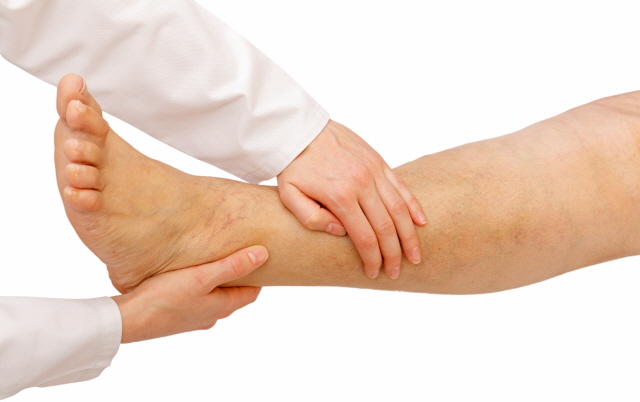
Finding A Guiding Herb Makes Easier to Find the Most Efficient Formula (23)
Indications Are Lower Body Swelling, Edema, and Short of Breath
By Hyunchang Cho, L.Ac., Ph.D (c0454445@gmail.com)
*Fang Ji: Symptom Indicator Score+++, Frequency of Use+++
-Main Symptoms: ①Water Edema: easily swells, especially in the legs, after standing or walking for a long time. ② Palpatory diagnosis: pitting edema along the tibial line is common.
-Possible Symptoms: ③Shortness of breath (cardiac asthma)
-CAPE: ④Yin-natured ⑤ Older people (in their 30’s or older) with weak stamina
- Pharmacological Hypothesis of Fang Ji
①Decreased cardiac function and output due to aging→cardiac dysfunction(heart failure)
②Gravity-related lower body swelling (pitting edema along the tibial line)→whole body edema (in severe cases)
③Or sometimes cardiopulmonary dysfunction→fluid accumulation in the chest cavity→shortness of breath (cardiac asthma)→w/o respiratory symptoms such as runny nose, phlegm, or cough
A good pathological model for explaining Fang Ji’s therapeutic effects would be cardiac dysfunction (heart failure).
It can lead to: Gravity-related lower body swelling (pitting edema along the tibial line), or whole-body edema. Sometimes, cardiac asthma is due to fluid accumulation in the chest cavity from cardiopulmonary dysfunction. Respiratory symptoms such as runny nose, phlegm, and coughing are absent in such cases.
A good therapeutic model for Fang Ji Pattern would be a cardiac failure.
Through recent pharmacological research, Fang Ji is known to remove fluid wastes in the chest cavity caused by cardiac failure. As we age, it is normal for cardiac function and output to deteriorate.
(1) Lower body swelling and pitting edema along the tibial line
Heart failure due to decreased cardiac output will cause gravity-dependent lower body swelling. It is why pitting edema along the tibial line is a common sign of Fang Ji.
Fang Ji’s pitting edema along the tibial line would appear as follows:
(2) Shortness of breath due to fluid retention in the chest cavity (cardiac asthma)
Heart failure due to decreased cardiac output would cause fluid retention in the chest cavity, cardiopulmonary dysfunction, and sometimes, cardiac asthma. Walking fast for a short distance would induce shortness of breath. An article about Mu Fang Ji Tang from Jin Kui Yao Lue refers to the type of asthma (shortness of breath) in the Fang Ji pattern.
- Clinical Tips for using Fang Ji
In Shang Han Lun and Jin Kui Yao Lue, Fang Ji is included in 6 formulas of Fang Ji Huang Qi Tang formulas, Fang Ji Fu Ling Tang, Mu Fang Ji Qu Shi Gao Jia Fu Ling Mang Xiao Tang, Ji Jiao Li Huang Wan, and Fang Ji Di Huang Tang. Fang Ji Huang Qi Tang formulas are the most commonly used, followed by Fang Ji Fu Ling Tang and sometimes Mu Fang Ji Tang formulas.
(1) Main Symptoms: ①Water Edema: easily swells, especially in the legs, after standing or walking for a long time. ②Palpatory diagnosis: pitting edema along the tibial line is common.
③External Signs of Water Edema: Pitting edema along the tibial line, Puffy face, Easily swells, Leg swelling after standing/walking for a long time, Sock marks, Shoes become tighter, Cannot remove rings in the morning (due to swelling)
Fang Ji’s Main Symptom is edema; therefore, external signs of edema (mentioned above) are often present in Fang Ji patients. In severe cases, systemic edema can also appear. Pitting edema along the tibial line is common. Pressing near the tibial line will produce edema with a pit.
Fang Ji’s pitting edema along the tibial line is usually present at level 1 or 2 pitting edema.
(2) Possible Symptoms: Shortness of breath (cardiac asthma)
Fang Ji’s shortness of breath is usually presented as cardiac asthma.
-Clinical Expressions: ①Exercise-induced asthma that is triggered by exercise or moving fast. Patients say they cannot go hiking because they’d be out of breath. Fang Ji patients avoid climbing, rigorous exercising, walking fast, or running. ②Because it is not respiratory but cardiac asthma, it is usually just shortness of breath without respiratory symptoms such as coughing, phlegm, or runny nose. ③Chest fullness due to shortness of breath. Such chest fullness will usually be absent if shortness of breath does not occur, meaning that it is a resultant symptom of shortness of breath. Chest fullness w/o shortness of breath is rare in the Fang Ji pattern.
(3) CAPE 形色性情: Body type: obese to moderate, with plump, moist skin. They are rarely muscular or well-built.
-Stamina: easily tired/ fatigued due to weak stamina.
-Complexion: dark or pale, with white/yellow/black/brown skin tones. Puffy faces/eyelids are common.
-Personality: Mostly Yin-natured → people who can be described as slow/soft/static/mild, speaking/behaving timid/weak/slow.
Gender/Age: Mostly older people (in their 30’s or older)
































